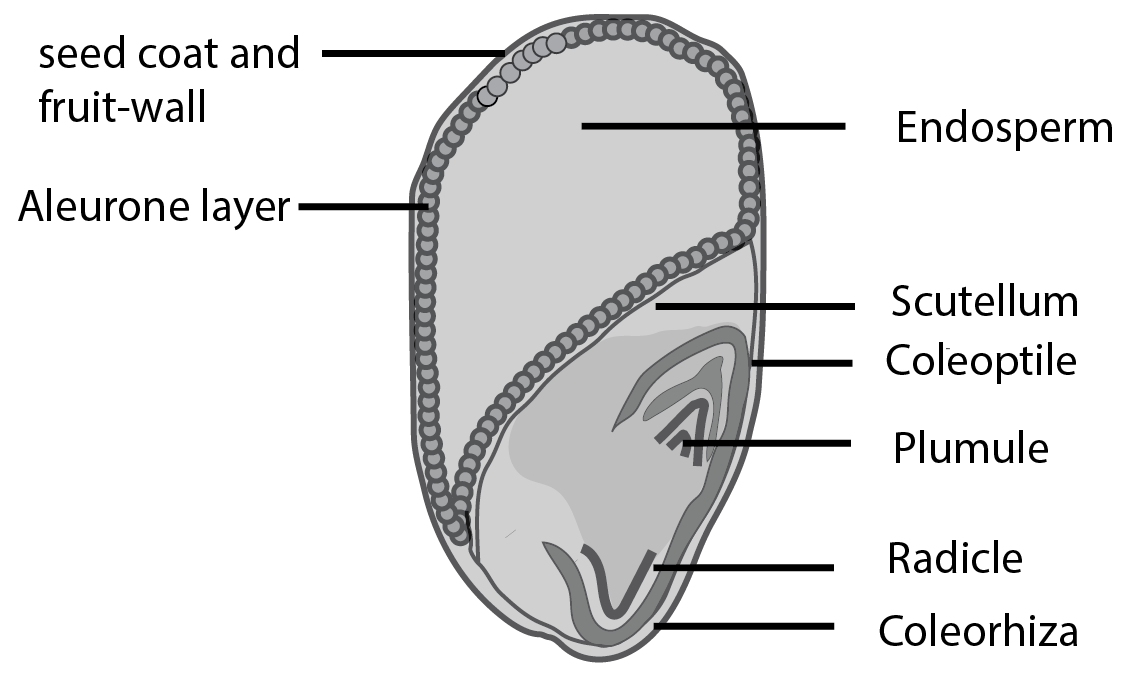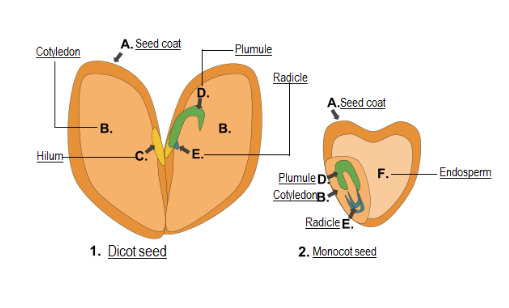Key Functions of Each Seed Part Explained
Seeds are the foundation of new plant growth. They lie dormant until they receive the right conditions to germinate, such as adequate sunlight, water, and soil. In this article, we will discuss the 3 parts of a seed and show simple parts and their functions. We will also cover monocot and dicot seeds, provide learning tips, and include a short quiz at the end. Read this article to learn and understand about seeds easily.
Overview of Seed Structure

What are the parts of seeds? In general, every seed contains three major components:
Seed Coat
Endosperm
Embryo
These 3 main parts of a seed and their functions work together to ensure successful seed germination and the development of a healthy plant. Let us explore each one in detail.
Seed Coat: The Protective Shield
The seed coat is the tough outer layer that safeguards the inner components of the seed from damage, extreme temperatures, and parasites. It has two layers:
Testa: The thick outer layer which shields the seed from physical harm and prevents excessive water loss.
Tegmen: The thinner inner layer, which also helps protect the developing embryo.
Two important structures visible on some seed coats are:
Micropyle: A tiny opening through which the seed absorbs water and minerals necessary for germination.
Hilum: The scar left behind where the seed was once attached to the fruit (similar to a ‘navel’ in humans).
A strong seed coat helps prevent germination under unfavourable conditions, allowing the seed to survive until the environment is suitable.
Endosperm: The Nutrient Storehouse
The endosperm lies just beneath the seed coat in many seeds. It is a rich source of nutrition that supports the embryo until it can produce leaves and begin photosynthesis. Key points include:
Nutritional Content: Primarily composed of starch, carbohydrates, and proteins.
Role in Different Seeds:
In cereals like corn, the endosperm is a large portion of the seed.
In seeds such as beans, the endosperm is used up during embryonic development, so it is usually absent in the mature seed.
Coconuts contain liquid endosperm (the coconut water) as well as solid endosperm (the white coconut flesh).
The endosperm ensures the young embryo can remain viable until it sprouts.
Embryo: The Future Plant
The embryo is the heart of the seed. It is diploid (containing two sets of chromosomes) and develops from a fertilised egg cell. All the cells required to form a new plant are present here. The embryo has several parts:
Epicotyl: This tiny shoot will eventually develop into the plant’s shoot system (stems and leaves).
Hypocotyl: The region connecting the radicle and the cotyledons; sometimes referred to as the part that forms the primary root in certain germination types.
Radicle: The first embryonic root to appear during germination. It anchors the plant in the soil and starts absorbing water and nutrients.
Cotyledons: Also called “seed leaves”, they store food (starch and proteins) and may also appear above the ground during germination to aid in early photosynthesis.
Monocot and Dicot Seeds
Seeds can be broadly grouped into two types:
Monocotyledonous (Monocot) Seeds
Contain a single cotyledon (e.g., rice, wheat, maize).
Often, they have a large endosperm that provides nourishment to the embryo.
Dicotyledonous (Dicot) Seeds
Contain two cotyledons (e.g., bean, tomato, pea).
The cotyledons are typically fleshy and may store nutrients instead of an endosperm.
Learning the difference between monocot and dicot seeds further enriches your understanding of parts of a seed and their functions.

Practice Quiz with Answers
Test your understanding with this quick quiz:
Which part of the seed stores food for the developing embryo?
A. Seed Coat
B. Endosperm
C. Hilum
D. Micropyle
Which of the following is the first structure to emerge during germination?
A. Epicotyl
B. Radicle
C. Cotyledon
D. Hilum
Which layer of the seed coat is thick and protective?
A. Tegmen
B. Testa
C. Micropyle
D. Epicotyl
What are the parts of seeds?
A. Seed Coat, Endosperm, and Embryo
B. Testa, Tegmen, and Micropyle
C. Epicotyl, Radicle, and Cotyledons
D. Monocot and Dicot
Answers:
B
B
B
A
Related Topics


FAQs on Parts of a Seed: Structure, Functions, and Types
1. What are the three primary parts of a typical seed?
A typical seed consists of three primary parts: the Seed Coat, the Embryo, and a food storage tissue, which can be the endosperm or the cotyledons. The seed coat provides external protection, while the embryo is the miniature plant waiting to germinate.
2. What is the function of each main part of a seed?
The main parts of a seed have distinct functions for the plant's life cycle:
- Seed Coat (Testa): This is the tough outer layer that provides protection against mechanical injury, dehydration, and pests.
- Embryo: This is the most crucial part, containing the genetic blueprint to grow into a new plant. It consists of a radicle (embryonic root), a plumule (embryonic shoot), and cotyledons.
- Endosperm/Cotyledons: This tissue provides nutritive support to the embryo during germination, supplying the energy needed for growth until the new plant can perform photosynthesis.
3. What is the main difference between a monocot and a dicot seed?
The primary difference lies in the number of cotyledons (seed leaves). Monocot seeds, such as maize and rice, possess a single cotyledon. In contrast, dicot seeds, such as beans and peas, have two cotyledons. This fundamental difference also influences their structure and how they store food for the embryo.
4. Are all seeds endospermic? Explain with examples.
No, not all mature seeds are endospermic. Based on the presence of the endosperm at maturity, seeds are classified as:
- Endospermic (or Albuminous) seeds: These seeds retain the endosperm as the primary food storage tissue. Examples include castor, maize, and wheat.
- Non-endospermic (or Exalbuminous) seeds: In these seeds, the endosperm is completely consumed during embryo development, and food is stored in the fleshy cotyledons. Examples include pea, bean, and gram.
5. Why do some seeds like peas store food in cotyledons while others like castor use an endosperm?
This difference reflects two distinct developmental strategies. In pea seeds (non-endospermic), the embryo absorbs all nutrients from the endosperm *before* the seed matures and becomes dormant. The food is then conveniently stored in its large, fleshy cotyledons. In castor seeds (endospermic), the endosperm is not used up during development. It remains as a separate food source that the embryo consumes *during and after* germination to fuel its initial growth.
6. How does the seed coat's structure contribute to seed dormancy?
The seed coat, or testa, is crucial for survival by enforcing dormancy. It is often thick and impermeable to water and oxygen, which prevents the seed from germinating prematurely under temporarily suitable conditions. This structural barrier ensures the seed only breaks dormancy and germinates when environmental signals, like sustained moisture and correct temperature, are stable enough to support the seedling's long-term survival.
7. What are the components of the embryonal axis in a dicot seed?
The embryonal axis is the core part of the embryo from which the plant develops. In a dicot seed, it consists of two key components:
- The plumule, which is the embryonic shoot destined to grow upwards and form the stem and leaves.
- The radicle, which is the embryonic root that will grow downwards to establish the primary root system of the plant.
8. What are the specific roles of the coleoptile and coleorhiza in a monocot seed?
In a monocot seed like maize or rice, the coleoptile and coleorhiza are specialized protective sheaths. The coleoptile is a pointed, cap-like structure that covers the young shoot (plumule). Its main job is to protect the delicate shoot tip as it pushes through the abrasive soil. Similarly, the coleorhiza is an undifferentiated sheath that encloses the embryonic root (radicle), offering protection as it begins its growth into the soil.
9. What role does the micropyle play in the process of seed germination?
The micropyle, a tiny pore in the seed coat, is vital for initiating germination. Its primary role is to act as the main gateway for water absorption. This intake of water, known as imbibition, rehydrates the seed's tissues and triggers the metabolic activities within the embryo. This swelling causes the seed coat to rupture and allows the radicle to emerge, officially starting the growth of a new plant.










